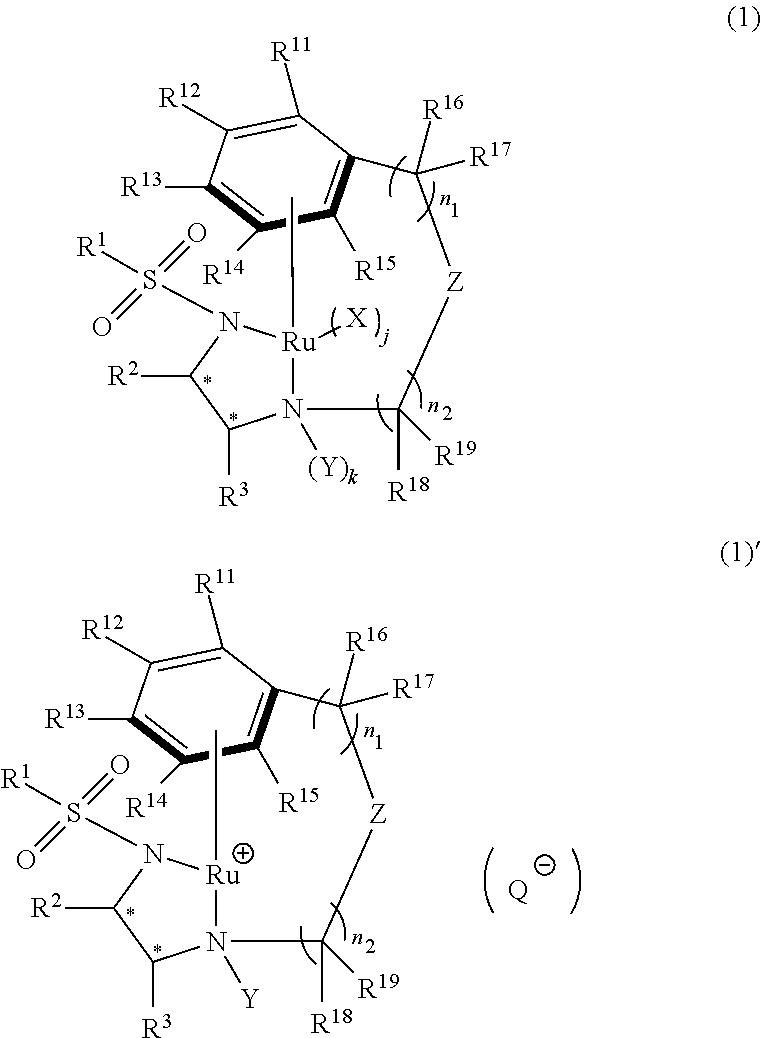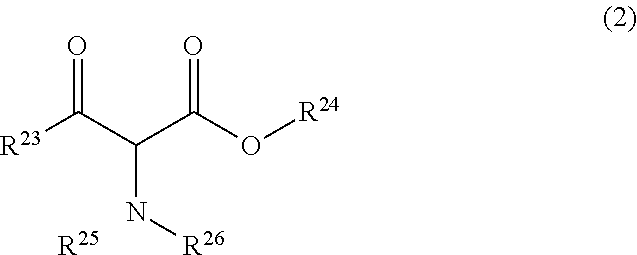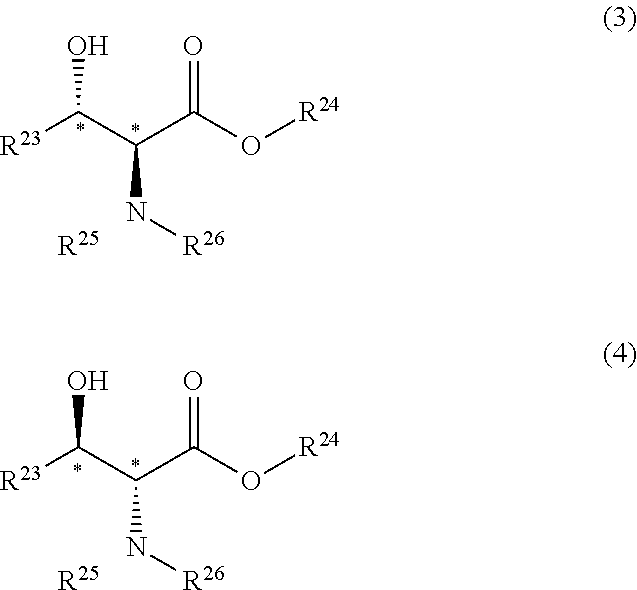Method for producing optically active beta-hydroxy-alpha-aminocarboxylic acid ester
a technology of beta-hydroxy-alpha-aminocarboxylic acid and ester, which is applied in the field of new products, can solve the problems of long reaction time, low stereo selectivity, and complicate the operation for removing the catalyst, and achieves the effects of simple steps, high catalytic activity, and low cos
- Summary
- Abstract
- Description
- Claims
- Application Information
AI Technical Summary
Benefits of technology
Problems solved by technology
Method used
Image
Examples
example 1
Production of methyl (2R,3R)-2-acetylamino-3-hydroxyoctadecanoate
[0273]To a solution of RuCl((R,R)—O-HT-TsDPEN) (6.5 mg, 0.01 mmol) produced in Synthesis 5 and methyl 2-acetylamino-3-oxooctadecanoate (0.93 g, 2.50 mmol) in 1,4-dioxane (4.6 ml), triethylamine (0.758 g, 7.5 mmol) and formic acid (0.345 g, 7.5 mmol) were added. Then, the mixture was heated to 90° C., and stirring was continued for 6 hours. A sample was taken out, and analyzed by HPLC. As a result, the conversion was 99%. In addition, the ratio between the anti isomer ((2R,3R) isomer) and the syn isomer((2S,3R) isomer) was as followes; anti isomer:syn isomer=90.5:9.5.
[0274]After cooling to 20° C., the reaction liquied was washed with water, and drived over magnesium sulfate. The solvent was recovered under reduced pressure. Thus, the titled compound was obtained. The obtained crude product was analyzed by comparison with a standard substance. As a result, the content of the titled compound was 0.88 g, and the yield ther...
example 2
Production of methyl (2R,3R)-2-acetylamino-3-hydroxyoctadecanoate
[0275]To a solution of RuCl((R,R)—O-HT-TIPPsDPEN) (7.6 mg, 0.01 mmol) produced in Synthesis 9 and methyl 2-acetylamino-3-oxooctadecanoate (0.93 g, 2.50 mmol) in 1,4-dioxane (4.6 ml), triethylamine (0.758 g, 7.5 mmol) and formic acid (0.345 g, 7.5 mmol) were added. The mixture was heated to 90° C., and stirring was continued for 6 hours. A sample was taken out, and analyzed by HPLC. As a result, the conversion was 70%. In addition, the ratio between the anti isomer ((2R,3R) isomer) and the syn isomer ((2S,3R) isomer) was as follows: anti isomer:syn isomer=92.5:7.5. In addition, the optical purity of the anti isomer was 97% ee.
examples 3 to 5
Production of methyl (2R,3R)-2-acetylamino-3-hydroxyoctadecanoate
[0280]Different amines were added respectively to solutions each containing RuCl((R,R)—O-HT-TsDPEN) (6.5 mg, 0.01 mmol) produced in Synthesis 5 and methyl 2-acetylamino-3-oxooctadecanoate (0.93 g, 2.50 mmol) in tetrahydrofuran (4.6 ml). Then, formic acid (0.345 g, 7.5 mmol) was further added to this mixture, and stirring was continued at 30° C. for 20 hours.
[0281]Table 2 shows the results.
TABLE 2Amine / Temp. / Time / Conv. / De / ExampleCatalysts / cAmineeq.° C.hour%anti:syn% de3RuCl((R,R)-O-HT-TsDPEN)250Et3N330208094.2:5.888.44RuCl((R,R)-O-HT-TsDPEN)250nBu3N330208593.7:6.387.45RuCl((R,R)-O-HT-TsDPEN)250EtN(iPr)2330209594.9:5.189.8Et3N: TriethylaminenBu3N: Tri-n-butylamineEtN(iPr)2: Diisopropylethylamine
[0282]Examples 3 to 5 showed that the use of tertiary organic amines made it possible to complete the reaction even under a mild temperature condition (30° C.) in a relatively short reaction time (20 hours), and to achieve high ra...
PUM
| Property | Measurement | Unit |
|---|---|---|
| reaction time | aaaaa | aaaaa |
| molar ratio | aaaaa | aaaaa |
| pressure | aaaaa | aaaaa |
Abstract
Description
Claims
Application Information
 Login to View More
Login to View More - R&D
- Intellectual Property
- Life Sciences
- Materials
- Tech Scout
- Unparalleled Data Quality
- Higher Quality Content
- 60% Fewer Hallucinations
Browse by: Latest US Patents, China's latest patents, Technical Efficacy Thesaurus, Application Domain, Technology Topic, Popular Technical Reports.
© 2025 PatSnap. All rights reserved.Legal|Privacy policy|Modern Slavery Act Transparency Statement|Sitemap|About US| Contact US: help@patsnap.com



